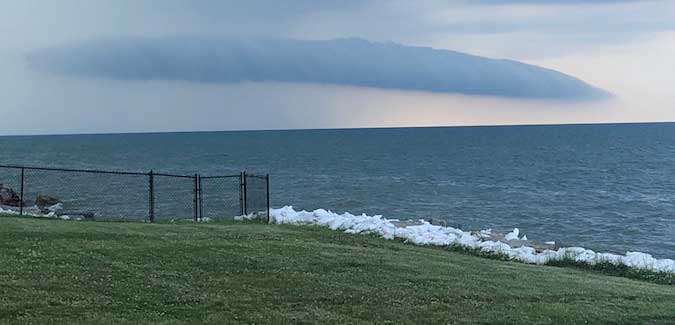IJC will continue record outflows to lower lake level

Provided photo: David Nichols sent in this photo looking out at Lake Ontario on July 4 from his cottage on the shore of Lyndonville.
Press Release, International Joint Commission
At its meeting on July 5, the Board for the International Joint Commission reached consensus to maintain the current outflow, which is 200 m3/s (7,060 cfs) higher than regulation Plan 2014 and the maximum safe navigation limit that would normally apply at these lake levels. The Seaway Corporations have implemented mitigation measures to allow safe navigation to continue at these higher flows, which will continue to lower Lake Ontario levels and provide relief to those impacted by this year’s high water event.
The Board deliberated several outflow strategies above 10,400 m3/s and considered both the additional decline on Lake Ontario and impacts to other stakeholders. These scenarios included incremental increases all the way up to maximum outflow capacity of the St. Lawrence River. At present, any additional increase in flow would require the Seaway Corporations to shut down shipping on the St. Lawrence River between St. Lambert and Cape Vincent.
The economic costs for disrupting the supply chain of the Great Lakes-St. Lawrence economy is estimated at $50 million per day. Additional impacts were also expected for recreational boating and downstream shoreline property owners, including resumed and additional flooding in areas of the lower St. Lawrence River just upstream of Montreal. Additional environmental impacts were also expected due to sustained high flows, including impacts to fish, wildlife and waterfowl habitat and breeding grounds.
Outflows at maximum system capacity for 4 weeks would hasten the recovery of Lake Ontario in the short-term; however, when compared to maintaining the current record high outflow strategy both options converge to within 1 inch by Dec. 31.
This is because the amount of water that can be physically passed down the St. Lawrence River is directly related to the level of Lake Ontario. As the lake declines, so does maximum river capacity. Maintaining the current major deviation strategy will provide comparable benefit by the end of the calendar year, without creating $1.4 billion in economic damages.
The Board has also agreed to maintain the flow at 10,400 m3/s (367,270 cfs) for a longer duration than in 2017, until water levels on Lake Ontario drop more than 30 cm (1 foot) and fall below 75.50 m (247.7 ft). Current forecasts suggest this may occur around mid-August, depending on water supplies.
In addition, the Board has notified the Seaway Corporations that it will continue to set outflows at approximately 200 m3/s (7,060 cubic feet per second) above the normal safe navigation flow limit into the fall to continue lowering Lake Ontario levels at an accelerated rate. The Seaway Corporations will maintain mitigation measures to ensure safe navigation can continue during this period.
These enhanced outflow measures will help to provide both immediate and longer-term relief to all impacted upstream shoreline residents and property owners due to the high water levels. The intent of the Board is to lower water levels as much as possible prior to winter. It should be noted that the Board can only control outflows and not the water supplies to Lake Ontario. While the higher outflows will accelerate the rate of lowering that would otherwise occur, it is not possible, this year or any other, to lower Lake Ontario to a predetermined “safe” water level by the onset of winter.
The International Joint Commission has asked the Great Lakes-St. Lawrence River Adaptive Management (GLAM) Committee to expedite their ongoing review of Plan 2014. The Board will release a statement later this week describing the extents of the GLAM assessment.









































































